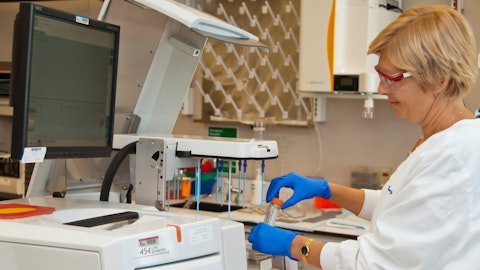As we look at Wakix represented $1-billion-plus opportunity in adult narcolepsy alone.
Jeffrey Dayno: Yeah. So David, let me address the second question with regards to new formulations in IH. So the new formulation of pitolisant, the thinking there is, obviously, we have an innovative product with a novel mechanism of action and the opportunity for formulation work in new IP to extend the pitolisant franchise out, not just beyond 2030, but 2040. With regards to idiopathic hypersomnia, let me be clear in terms of where we are coming off the INTUNE study. We saw a robust clinical effect in the trial in the open-label phase, and we are going through the full data set and reviewing that which will inform our strategy in terms of approaching the FDA as we continue to pursue the indication for IH based on the INTUNE study and those data.
So at this point, we expect to complete the review of the data by the end of November, and then we’re going to prepare briefing document, meeting requests soon after that and approach the agency. We remain committed to the IH patient community. We are actively pursuing an indication as a nonscheduled sort of product and the opportunity given the current treatment options for patients with IH. So we are not looking to new formulations, but we will pursue the IH indication based on the work that we’ve done thus far.
David Amsellem: Okay. Thank you.
Operator: Thank you. We will take our next question from Ami Fadia. Please — with Needham and Co. Please go ahead.
Eason Lee: Hi. Good morning. This is Eason Lee on for Ami. Congrats on the Wakix growth in the quarter, and thanks for taking our questions. Two, if I can. Historically, it looks like kind of the sequential adds in average patients on Wakix from Q2 to Q3 turn out similar to that from Q3 to Q4. Any factors this quarter you’d highlight, such that we would not expect a similar dynamic to occur this year? And then maybe my second question is, as we’re nearing the end of the year, would love to know your latest thinking on potentially providing 2024 Wakix sales guidance at the next earnings update or otherwise. Thank you.
Jeffrey Dayno: Mr. Eason, thanks for the question. Jeff Dierks, on the first one.
Jeffrey Dierks: Sure. So Eason, with respect to thinking about Q4 with respect to average number of patient growth adds per quarter, so again, we continue to be extremely pleased with the continued growth in the average number of patients and our obviously underlying strong business fundamentals. We saw a sequential add of approximately 350 average patients from what we reported in Q2. And I think the impressive growth that we’re seeing in the average patients in the third quarter was driven by strong top-line demand and new patient starts that offset the typical summer seasonality that we usually see every year. And it speaks to really not only continued product adoption, but most importantly, the large remaining diagnosed patient opportunity that we continue to tap into as the market allows.
While we’re not providing forward-looking guidance, we are pleased with the momentum heading into Q4, and we do anticipate and fully expect continued growth for Wakix for the remainder of ’23.
Jeffrey Dayno: Okay. Sandip, any comments or thoughts?
Sandip Kapadia: I think our guidance was the natural point, as you mentioned, was to consider guidance would be early next year. But even as you think back and look back at our performance over the last year and where analyst estimates are, generally, we’ve been pretty consistent overall, absent, obviously, inventory impact fluctuations quarter over quarter. We remain confident in Wakix being a $1 billion plus in narcolepsy alone, adult narcolepsy, and we’re continuing — that sort of is our mid- to long-term guidance, if you want to call it. And then we also see the opportunity to contribute additional $1 billion, if approved, in other current programs. So we’re confident in the long-term growth potential for Wakix. And with respect to probably short-term guidance and things like that, I mean, like I said, we’d consider early next year would be the natural point.
Eason Lee: Okay. Thanks, Sandip.
Sandip Kapadia: Thank you.
Operator: Thank you. We’ll take our next question from Charles Duncan with Cantor Fitzgerald. Please go ahead.
Charles Duncan: Yes. Good morning, Jeff and team. First of all, congratulations on a nice commercial quarter, and thanks for taking our question. I didn’t have any commercial questions that I wanted to ask, so I’ll just ask you on the pipeline, and that is primarily relative to the INTUNE study. We recently conducted a KOL call, and they were — that KOL was quite enthusiastic about the results that he saw. And so a question that I have for you is when you go to the agency, what will be the question? Will it be around possibly conducting a new study? Or will it be around evaluating the data in the INTUNE study alone and its open-label extension? Thanks.
Jeffrey Dayno: Hey. Good morning, Charles. Thank you for your question and sort of the feedback that you received on the INTUNE study. I mean, I think that the approach with the agency is really, first, as I mentioned, and I’ll turn it to Kumar, looking at all the data and understanding, obviously, the robust clinical effect that we saw upfront in the eight-week open-label phase and almost 90% of patients electing to go into the long-term extension, that continues on. And we also continue to collect long-term safety and effectiveness data that we could use to go to the agency, in addition to the data from the INTUNE study. The approach is to build a strong case with regards to the totality of the evidence coming out of the trial, along with the pitolisant-received orphan drug designation for IH that the FDA granted.
And then you look at the current treatment options. You look at overall benefit/risk. You look at the need, and we build the case and discuss that with the agency, where it could fit into treatment options. So that is the overall approach. And Kumar, I ask if you have any additional thoughts on strategy.




